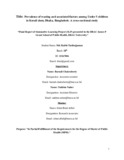| dc.contributor.advisor | Chakraborty, Barnali | |
| dc.contributor.advisor | Naher, Nahitun | |
| dc.contributor.author | Tarikujjaman, Md. Rabbi | |
| dc.date.accessioned | 2023-07-13T10:15:46Z | |
| dc.date.available | 2023-07-13T10:15:46Z | |
| dc.date.copyright | 2023 | |
| dc.date.issued | 2023 | |
| dc.identifier.other | ID 22167006 | |
| dc.identifier.uri | http://hdl.handle.net/10361/18820 | |
| dc.description | This project report is submitted in partial fulfillment of the requirements for the degree of Master of Public Health (MPH), 2023. | en_US |
| dc.description | Cataloged from the PDF version of the project report. | |
| dc.description | Includes bibliographical references (pages 27-30). | |
| dc.description.abstract | Introduction: Among Bangladeshi children under the age of five (U5), malnutrition is a major
health concern. Wasting is one of the malnutrition symptoms associated with malnourished
children's deaths. Southern Asia has a 14.1% prevalence of wasting, according to the world
nutrition survey. According to the Global Nutrition Report, the prevalence of wasting among
under-5 children is 9.8% in Bangladesh.
Objective: The goal of this research to assess the prevalence and associated factors of wasting
among Under 5 children in Korail slum.
Method: A descriptive cross-sectional study was conducted among 342 children under the age
of five living at Korail slum in Dhaka city from October 15, 2022 to January 11, 2023. A
standard anthropometric measurement method was used for the measurements. The
measurements were height and weight. Software named STATA 17 was used to analyze the data.
A multivariate and bivariate logistic regression analysis was conducted.
Findings: In this study, the mean age of under-5 children was 26.7 months. Male was 54.4% and
female was 45.6%. 10.23% of the anthropometric assessment was wasted based on the weight
for height Z-score. According to the study, females were more likely to suffer from wasting than
males.
Conclusion: In Bangladesh, under nutrition among children under the age of five is a public
health problem. We observed that the prevalence of wasting in Korail was slightly higher than
the national prevalence. To reduce the wasting status of children under 5 years old, the
government, nongovernmental organizations, and the community must work together. | en_US |
| dc.description.statementofresponsibility | Md. Rabbi Tarikujjaman | |
| dc.format.extent | 81 pages | |
| dc.language.iso | en | en_US |
| dc.publisher | Brac University | en_US |
| dc.rights | Brac University project reports are protected by copyright. They may be viewed from this source for any purpose, but reproduction or distribution in any format is prohibited without written permission. | |
| dc.rights | Environmentally induced diseases in children | |
| dc.rights | Children--Health and hygiene | |
| dc.subject | Children | en_US |
| dc.subject | Malnutrition | en_US |
| dc.subject | Korail slum | en_US |
| dc.title | Prevalence of wasting and associated factors among under 5 children in Korail slum, Dhaka, Bangladesh: a cross-sectional study | en_US |
| dc.type | Project report | en_US |
| dc.contributor.department | James P Grant School of Public Health, Brac University | |
| dc.description.degree | M. Public Health | |

